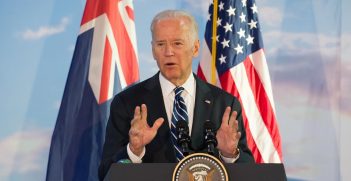The Universal Declaration of Human Rights at 70: Protection of Human Rights in Australia

As the Universal Declaration of Human Rights reaches its 72nd year, it is worth considering it in terms of the protection of human rights within Australia. Australia has failed to implement domestically the terms of the two founding Covenants. What exists today are piecemeal protections that exist for human rights.
2018 marked the 70th anniversary of the proclamation of the Universal Declaration of Human Rights (UDHR), and in 2020 Australia remains the only Western liberal democratic country in the world that has not implemented a domestic bill of rights. Having ratified the two founding Covenants which give the UDHR force under international law, and many other multilateral human rights treaties, Australia has taken only a piecemeal approach to the domestic implementation of their terms.
What has been interesting about the influence of the UDHR and its two founding Covenants on Australia is their exposure of our dual citizenship in this area. Australian diplomats were involved in the drafting of the UDHR and other human rights instruments, and on the world stage Australian politicians advocate the protection of human rights and posit Australia as a world leader in democratic rights, while condemning other countries that are not rights-protecting.
However, domestically it is a very different story. Australia’s ratification of both implementing Covenants (ICCPR and ICESCR) and other human rights treaties has had relatively little direct influence in Australia. Because treaties are not self-executing, they are not automatically enforceable in domestic law, although they can be used to help clarify statutory interpretation where an ambiguity exists in domestic law. For international treaties to be directly enforceable, the government has to enact domestic, enabling legislation. The best way to implement the terms of the ICCPR domestically would be through a statutory Bill of Rights, which is a highly contentious idea—we know this because so many previous attempts to implement one have failed.
In the late nineteenth century, the drafters of the Australian Constitution were well aware of the United States’ Bill of Rights, and one of the Constitution’s founders, Andrew Inglis Clark, was an open advocate of “the reality of the fundamental rights of man.” Clark’s attempt to insert an amendment that would have secured citizenship rights, prevented the deprivation of life, liberty or property without due process, and granted equal protection under the law was unsuccessful, and we were left instead with three “hedged and technical” rights provisions in the final version of our written Constitution. History tells us the reasons for this resistance to including express rights in the founding document were not necessarily benign, but included desires on the part of the states to continue to discriminate against Indigenous peoples and non-white immigrants.
In the time since ratification of the UDHR, there have been four attempts to introduce a Bill of Rights in either constitutional form through a referendum, or in statutory form by federal parliament—in 1973, 1983, 1985 and 1988. All failed in the context of a utilitarian political culture. There have been numerous other discussions on the topic, including the 2009 national human rights consultation, the largest national consultation ever conducted in Australia, which involved four months of travel around the country and more than 35,000 public submissions.
The report of the consultation recommended a range of changes to protect human rights, including better education and parliamentary scrutiny of legislation. It also recommended the adoption of a statutory Bill of Rights, but this was rejected by the federal ALP government of the day. Thus far, three sub-national jurisdictions have enacted statutory bills of rights—the ACT, Victoria, and most recently Queensland.
It remains the case that, domestically, the complex mix in Australia of anti-discrimination law, privacy law, common law, and the indirect influence of international law have not been adequate to protect rights comprehensively, with considerable examples of rights-breaching behaviour by both federal and state/territory governments. Just to give a few examples.
In 2014 Tasmania enacted legislation designed to prevent or deter the ability of protesters to stop the operations of a commercial enterprise as a form of political protest. The draft of the legislation was so draconian that it attracted the condemnation of three United Nations Special Rapporteurs. The law that was enacted prohibited protests that hinder or obstruct business activities in mining, forestry and agriculture, construction and manufacturing. It defined the kinds of protests with which the legislation is concerned as those which further or promote “awareness of, or support for,” an “opinion or belief in respect of a political, environmental, social, cultural or economic issue.” This means the legislation is specifically designed to deter non-violent, peaceful political advocacy.
In 2016, the law was used to charge anti-logging activists who were protesting the clearfelling of native forests. Veteran environmentalist Bob Brown challenged the law in the High Court, and won on the ground that the law was vague and therefore too broad in its effect on protest activity. This was only the second invalidation of a law under the implied freedom of political communication since the development of that doctrine in 1992. But in the 2018 Tasmanian State election the conservative party promised, if elected, to write a new anti-protest law that would survive a constitutional challenge to its validity on the basis of the implied freedom of political communication.
In 2016, New South Wales enacted a very similar law designed to deter protests, which imposed criminal penalties on a person who “interferes with, or attempts or intends to interfere with, the conduct” of a business. The law included an expansion of police powers to stop, search and detain people without warrants. After the High Court judgment in the Bob Brown case, there was pressure on the NSW government to consider repealing its law, because its similarity to the invalidated Tasmanian law rendered it also likely to be invalid on the ground of the implied freedom of political communication. Three anti-coal mine activists had been charged in 2017 over their protests against a coal mine, and at the time of the High Court’s judgement in the Tasmanian case, their case was still pending. However, in June 2018 a magistrate dismissed those charges. In spite of this, the NSW government seems determined to press on. In June 2018 it announced new provisions that would allow it to ban gatherings on public land.
In October 2016, Michel Forst, the United Nations Special Rapporteur on the situation of human rights defenders gave an End of Mission Statement after visiting Australia. He critiqued, among other things, a chilling effect on civil society, funding cuts, gagging clauses in funding agreements, secrecy laws and undermining of the Australian Human Rights Commission. This is not the only critical report from the United Nations—Australia has been criticised for its asylum seeker policy, which has been described as contrary to fundamental principles, and hugely detrimental, and its Indigenous affairs policy, which has been described as “woefully inadequate.” Indeed, the United Nations has noted Australia’s history of “chronic non-compliance” with recommendations by its committees. There is considerable evidence that Australia is not abiding by its obligations under international law in several policy areas.
Nevertheless, it is also important to recognise that human rights are not absolute. How do we balance competing rights, or the exercise of rights in ways that can harm others? For example, does freedom of expression include the right to say anything a person wants, or do minorities at whom harmful speech is targeted have the right to live a life free from discrimination and fear, and in human dignity? Freedom of speech seems to be the human rights debate of our time; the topic du jour—whether it’s about a baker having the right to refuse to bake a cake for a gay couple’s wedding, or the insistence that Australia’s marriage equality survey was actually about “free speech,” free speech is in the news.
All human rights carry with them commensurate responsibilities; you cannot understand rights without also understanding the responsibilities they impose on rightsholders to others who possess the same rights they do, and whose rights they have a duty not to infringe. This includes freedom of speech, one of the responsibilities of which is the responsibility not to use one’s speech to harm others. Of course, some people would argue that speech does not harm others, it is just the externalisation of thought, and it does not have the capacity to harm in material ways. But we do things with our words all the time; we give permission, we judge, we allow, we condemn, we deny, we extol, we praise, and so on. The things we do with words can have legally binding impacts, such as the act of getting married. So it does not seem feasible to argue that speech is simply the externalisation of thought. And if we can do things with our words, then it seems logical that we can do both good and bad things with our words. This means that words are at least capable of harm. Freedom of speech is fundamental to the exercise and enjoyment of many other rights, but that does not mean it is absolute.
We saw this in the controversy over Steve Bannon being offered a platform to speak at a festival organised by the New Yorker, which led to such an outcry that he was disinvited. By contrast, Bannon’s invitation to another event by the Economist was upheld against similar calls for him to be disinvited. In my view, the action by the New Yorker to disinvite Bannon was the right one. Bannon already has a platform that exceeds that of most other people. His views have been well aired in the public sphere, where they can and should be argued against and interrogated. The views he holds need to be debated, but that debate does not require that he have the kind of high-profile platform that can be offered by headlining an event hosted by the New Yorker. Giving him such a platform provides a level of legitimacy to his views that is likely to increase the potential harms of his speech. His speech is designed to shut down the speech of others, especially those who are vulnerable and marginalised from the public debate he craves, and that is essential to their own well-being. Having the security and profile of this platform would amplify the power of Bannon’s speech to do harm. Additionally, no-one has a “right” on the ground of freedom of speech to be invited to an event such as this; private events take place all the time in relation to which organisers make decisions as to whom to invite, and to whom to give a voice. Finally, taking steps to ensure that the public sphere is not dominated by some speakers, whose exercise of free speech would shut down the free speech of others, enhances the exercise of the freedom of speech, rather than restricting it.
The dilemma of increasing complexity has, at the same time, rendered human rights more vulnerable to those who decry them, and to those who seek to use the language of rights in ways that distort its meaning. As former Human Rights Commissioner, Gillian Triggs, has stated, in Australia
tensions among different rights have sparked the “freedom wars,” essentially a debate about how to ensure liberty of the individual while also ensuring equality and non-discrimination. Some argue that Australia has become a nanny state that unnecessarily restricts individual autonomy. They reject treaties setting out universal norms of human rights, reject the findings of the United Nations’ Human Rights monitoring committees and ignore the concerns of the UN Human Rights Commissioner and the UN High Commissioner for Refugees.
She concluded that,
prioritizing freedoms, one against another, is a false and fruitless exercise … Protecting vulnerable members of the community against discrimination and ensuring fundamental freedoms is not a choice between alternatives. Rather, we should focus on how to protect and accommodate all freedoms for an inclusive and fair society.
Although it is undoubtedly the case that human rights in Australia are protected better today than they were at the time of the drafting of the UDHR (think marriage equality, women’s advancement in the workforce, the National Disability Insurance Scheme), it is also true that human rights continue to be at risk in Australia. Risks remain from piecemeal protection and the exclusion of some sectors of society—Indigenous peoples, women, and asylum seekers, for example —from the rights granted to others. Today, we face new risks, one of which is the use of rights-protecting language by those who have little real concern with the protection of rights for all. In this context, the occasion of the anniversary of the UDHR presents a good opportunity to reaffirm our commitment to the universality, inherence and inalienability of human rights.
Katharine Gelber is Professor of Politics and Public Policy at the University of Queensland .
This is an extract from Professor Gelber’s article “The Universal Declaration of Human Rights at 70: Protection of Human Rights in Australia” originally published in the Australian Journal of International Affairs.





